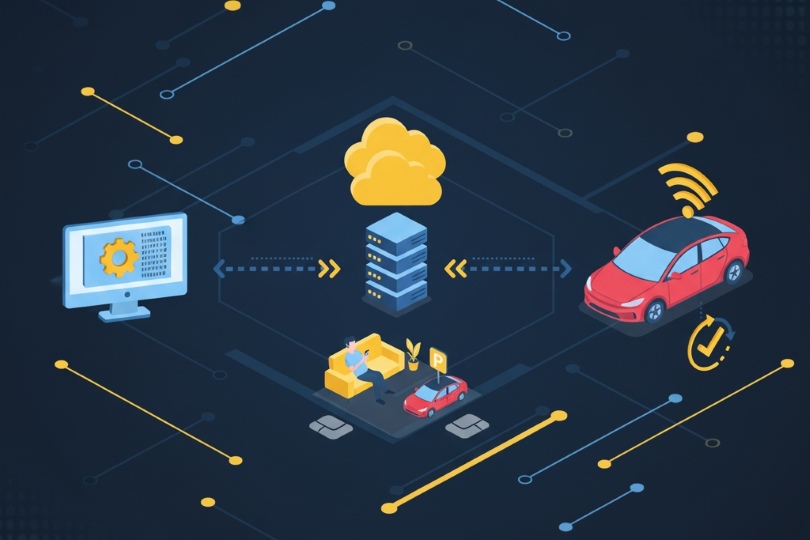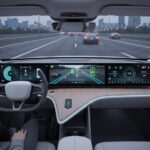Get your phone now and press that update button. It will make your phone a hundred times better, right? Well, electric vehicles (EVs) have taken that concept to another level with OTA updates. These software updates are not limited to bug fixes. It can add functionalities such as safety systems, driving performance, and even your car’s battery boost without visiting your dealership. A game-changer for making car maintenance less hassle! Want to know more about the latest OTA updates in EVs? Stick around and we’ll break it all down for you.
What Are OTA Software Updates in EVs?
Over-The-Air (OTA) is used to describe the process of deploying software in a computer system remotely through wireless communication. Think of it like how our smartphones receive updates. Now, that same process is transforming vehicle interaction by providing continuous improvement long after the initial purchase date. In connected cars, OTA updates can affect everything from the climate control system to core driving performance and essential safety features.
Over-the-air software updates in electric vehicles are technologically dependent on a good connection. Cars produced today have high-tech communication units that use networks such as 4G, 5G, and Wi-Fi. That guarantees a car will always be connected to the internet and can receive updates anytime, anywhere. When an update is available, the package is sent safely through the internet and is downloaded into the onboard computer in the car.
Installation is usually done when the car is parked or not in motion [often during the night] to avoid unwanted circumstance. Once well installed and validated, the vehicle system boots again and the new functionality, bug fixes, or performance optimizations are now available.
OTA updates are categorized based on the depth of the system being updated:
⦁ SOTA (Software Over-the-Air): These updates target application-layer components. Here are those systems that the user can clearly see, including the navigation, infotainment and climate control systems.
⦁ FOTA (Firmware Over-the-Air): These are deeper, more critical updates. FOTA is aimed at the vehicle firmware updates that is actually in charge of pertinent hardware functions, including the powertrain or Battery Management System (BMS).
The Core Drivers Pushing OTA Updates Forward
The rapid growth of the OTA market is mainly driven by the exponential growth of the EV segment and changing consumer demand for digital products.
➜ Expanding EV Market
Electric cars are complex software-intensive machines. They rely heavily on code to manage complex systems like Advanced Driver Assistance Systems (ADAS) and to optimize battery performance and efficiency. Such complexity requires remote software adjustment, which must be carried out at all times.
In fact, the rate of market adoption shows this need in the automotive industry as a whole. By late 2023, approximately 309 models across 23 brands were already equipped with OTA capabilities. A rapid spread that justifies how OTA is becoming a universal standard, not a niche feature anymore.
But wait, there’s more! According to recent studies, the demand is especially high in areas where EV production and uptake are strong. In 2024, the market size was estimated to be USD 3.64 billion and is expected to expand significantly with a Compound Annual Growth Rate (CAGR) of more than 17.94% from 2026 to 2032. Now that’s a potential increase of up to USD 12.14 billion. All these EV technology updates only suggest that OTA capability is fast emerging as it’s the inseparable core of the electrified mobility ecosystem.
➜ Consumer Expectations
Modern consumers are accustomed to the seamless functionality of connected devices. Thus, these people expect their major investments to deliver continuous improvement and digital longevity.
A key driver of growth in the OTA market is the blistering development of vehicle infotainment systems. With consumers seeking more advanced in-car entertainment and connectivity features, manufacturers must leverage OTA updates to constantly improve user interfaces, add new applications, and increase system performance.
Benefits of OTA Updates in EVs
OTA updates provide radical convenience, operational cost management, performance and safety benefits in changing the vehicle life cycle both to the owner and the manufacturer.
(a) Performance Enhancement
Software updates allow manufacturers to instantly recalibrate a vehicle’s core operating parameters. This feature helps to remotely implement the performance improvements resulting in a smoother acceleration, enhanced torque delivery, and handling improvement. A prime example of this capability is seen with manufacturers like Tesla, which have used remote software updates to significantly boost 0 to 100 km/h acceleration times on existing hardware. This proves that an EV’s driving dynamics are not fixed at the point of sale. It may be enhanced dynamically only by means of refining the software.
(b) Cost Savings
From the owner’s perspective, OTA offers immeasurable convenience and reduced costs by sparing them the time and effort of traveling to a dealership to have their software-related maintenance done. Updates can be scheduled to occur when the car is parked, often overnight, resulting in zero downtime for the user. For manufacturers, avoiding physical service visits for software issues reduces administrative and logistical costs associated with traditional updates and minor recalls.
(c) Safety and Maintenance
The ability to respond quickly is also critical to solving the major safety issues. In case a bug is identified in a system, the automakers can update it nearly immediately through OTA. This rapid response mechanism has revolutionized how recalls are managed. Physical recalls are expensive and time-consuming. OTA fix is quick, which keeps customer satisfaction high and liability low.
To give an example, in August 2024, Tesla declared a recall of 1.68 million Model 3 and Model Y vehicles in China because of a problem with the frunk lid that could block the driver. That issue was resolved with the OTA update. But that’s not all. In the same light, Mercedes-Benz also used OTA technology to fix an issue in its e-Call system that affected 1.3 million of its vehicles.
(d) Unlocking New Features
OTA updates upgrade the feature set of the vehicle long after the time of sale. They are able to add a fully new functionality like improved autopilot modes, new interface designs or advanced parking assist functions.
Traditional automakers are moving toward this model to deliver stronger, value-added services. BMW has since introduced an OTA update to enable a dashcam on parts of their vehicles. Likewise, Mercedes-Benz uses remote updates to enable performance software, including the AMG Track Pack. Those efforts make a brand’s car more technologically relevant and competitive during its useful life.
Transition from Mechanical Systems
A true definition of a modern vehicle is shifting from mechanical expertise to software supremacy, leading to the Software-Defined Vehicle (SDV) era.
Legacy automakers traditionally utilized a domain architecture, characterized by decentralized electronic systems. In some premium vehicles, this involved 150 or more Electronic Control Units (ECUs), with functions grouped by domain (e.g., infotainment or powertrain). The resulting structural complexities, which are typically reinforced with the dependency on many third-party suppliers, affect architectural inertia significantly. That same reason makes large-scale, synchronized OTA updates exceptionally challenging to implement reliably.
The sector is currently shifting towards the zonal architecture. In this new architecture, ECUs and domain functions are fused into fewer zonal controllers in terms of physical site, controlled by a powerful central computing unit. Such centralization drastically simplifies the Electrical/Electronic (E/E) architecture, minimizes the number of components, and enables efficient system validation. The result? A more comprehensive, distant update of the entire vehicle within the scope of a single vehicle.
Real Challenges in Adopting OTA Updates
The fast transition to software control introduces critical risks and structural barriers that must be managed to ensure consumer trust and safety.
➜ Cybersecurity Risks
The higher connectivity of SDVs puts vehicles at high risk of potential cyber attacks, such as data malware and malicious intrusion. Companies in the auto industry should invest in robust security technologies, such as advanced encryption and strict authentication controls.
One of the most significant fears became reality in January 2023, as API vulnerabilities were found in luxury automobile companies (including Acura, BMW, Ferrari, Ford, Mercedes-Benz and Toyota). Such security vulnerabilities enabled remote access to some functions of the cars and access to sensitive customer information. It highlights the severity of car security, in which any digital attack immediately becomes a potentially deadly physical security concern.
➜ Complex Software Design
Companies with a traditional system have structural barriers to change because of legacy systems. They need to both deal with a wide range of vehicles (ICE, BEV, and PHEV) and operating systems (often incompatible) at the same time. This requires long, hardware-intensive development cycles, which severely lack the agility required for rapid OTA deployment.
Emerging Trends
Several technological trends are set to revolutionize the intelligence and efficiency of vehicle updates, including:
📈 AI and Predictive Maintenance. A significant trend is the combination of Artificial Intelligence (AI) and Machine Learning (ML), which will increase the customization of updates and efficiency. These technologies are capable of studying driving habits and vehicle information to find any software problems (small software bugs) before they can be serious. Such a proactive approach boosts vehicle reliability and reduces costly warranty claims.
📈 5G Network. 5G networks need to be rolled out further. The enhanced speed and reliability provided by 5G will enable seamless delivery of large software packages. A big benefit, particularly for extensive FOTA updates to critical systems.
📈 Efficiency and Standardization. Industry collaboration is focusing on optimization. Newer technologies such as Line-Of-Code Intelligence (LOCI) guarantee smaller update files and reliable rollbacks, which makes manufacturers a lot simpler and less expensive in terms of Total Cost of Ownership (TCO). Furthermore, a strong industry push for standardization (such as ASAM SOVD) seeks to eliminate vendor lock-in and establish OTA functionality as a universal, non-differentiated requirement across all vehicle platforms.
Conclusion
Indeed, it is evident that OTA updates aren’t just hype. It’s the manifestation for the future of auto revolution. From rolling out new features and AI-driven predictions to prioritizing convenience over service visits, OTA updates in EVs are redefining auto maintenance. As connectivity speeds get faster and smarter, EVs won’t just rely on battery breakthroughs but also on software that evolves and adapts. So the next time your car feels like it just had a glow-up overnight, thank those seamless OTA updates working behind the scenes to keep your ride smarter, safer, and always a step ahead.
—
Author: Maverick Steel is a writer and digital marketer who enjoys connecting the dots for strategy and engaging content. He spent 6 years in secondary education as a proud campus journalist, specializing in editorial and column writing. Holding a bachelor’s degree in Marketing Management, Maverick is also a devoted advocate for positive cyber citizenship and a certified pet lover. When he’s not busy writing, you can catch him hitting the gym or enjoying a matcha latte at the nearest aesthetic coffee shop.











